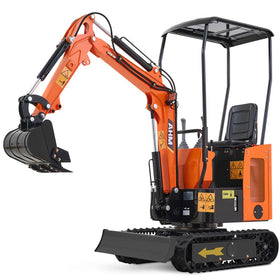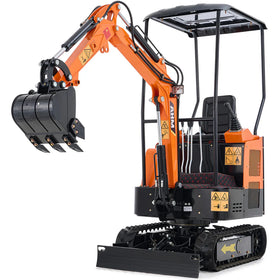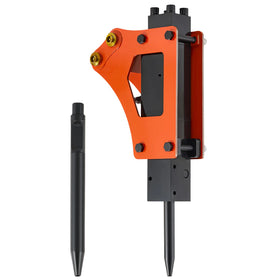Land grading isn't just some fancy landscaping term. It's actually one of the most crucial steps in any outdoor project, whether you're building a new deck, making a pool, or just trying to fix drainage issues that have been driving you crazy for years.
Get land grading wrong, and you'll be dealing with water damage, foundation problems, and expensive headaches down the road.

What Exactly is Land Grading?
Land grading is basically the process of reshaping and leveling the ground to create the proper slope and elevation for your needs. Think of it as giving your property a makeover - you're not just moving dirt around randomly, you're creating a foundation that actually works.
Land grading involves removing excess soil from high spots and adding fill material to low areas, creating a smooth, properly sloped surface that directs water away from buildings and other structures.
The goal of land grading is not always to make everything perfectly flat - in fact, that's usually the last thing you want. Instead, you're creating controlled slopes that manage water flow, prevent erosion, and provide stable ground for whatever you're planning to build.
When done right, proper grading can solve drainage problems, prevent basement flooding, create usable outdoor spaces, and even increase the value of your property.
The key to successful land grading work lies in understanding the natural flow of water across your property and working with it, not against it. You want to create gentle slopes (typically 2-5% grade) that move water away from structures while maintaining soil stability.

Types of Land Grading and When You Need Them
Grading land isn't a one-size-fits-all operation. Instead, you'll need different approaches depending on what you're trying to accomplish:
Rough Grading
Rough Grading is your heavy-duty earthmoving phase. This is where you're doing major reshaping - removing hills, filling valleys, and creating the basic contours of your site.
You'll typically need this for new construction projects, major landscaping overhauls, or when dealing with significant drainage issues.
Finished Grading
Finished Grading comes after the rough work is done. This is the precision phase where you're fine-tuning elevations, creating smooth transitions, and preparing the surface for concrete, landscaping, or building foundations. The tolerances here are much tighter, often within inches.
Drainage Grading
Drainage Grading focuses specifically on water management. You're creating swales, drainage channels, and proper slopes to direct water away from buildings. Drainage grading is crucial in areas with heavy rainfall or clay soils that don't drain well naturally.
You'll need rough grading when starting any major project - building additions, installing pools, creating new driveways, or solving serious drainage problems.
Finished grading is essential before any final construction work. The timing matters too, as the answer to the question ‘how much does land grading cost’ often depends on when you tackle different phases efficiently.
Best Equipment for Grading Land
Here's where things get interesting. Land grading equipment can make or break your project, and choosing the right tools isn't just about getting work done - it's about getting it done right, efficiently, and without breaking the bank.
1. Mini Excavators
When you need surgical precision in your grading work, mini excavators are hard to beat. At AHM, we've designed our mini excavator line specifically with grading applications in mind. Our AX-12B with its 13.5 HP Briggs & Stratton engine gives you the control you need for detailed finish grading work while being compact enough for tight residential spaces.
What makes mini excavators ideal for grading land work? The 360-degree rotation lets you position material exactly where you need it, the hydraulic controls give you incredible precision, and they're gentle on existing landscaping.
Our AX-16 series takes this up a notch with 23 HP engines and retractable undercarriages. You can narrow the machine to get through gates, then expand it for stability when moving serious amounts of material.
2. Skid Steers
Here's where AHM really shines in the land leveling and grading equipment category. Our skid steer attachments transform these machines into incredibly versatile grading tools.
Our 41" 4-in-1 Combo Mini Skid Steer Bucket at $1,159.99 (down from $1,559.99) is absolutely perfect for grading work. This isn't just a bucket - it's four tools in one. You can use it as a standard bucket for moving material, a dozer blade for rough grading, a clamp for grabbing objects, and a scraper for finish work.
The 110° maximum jaw opening angle gives you incredible versatility, and the 5 cubic foot capacity means you're moving meaningful amounts of dirt with each pass. For most residential grading projects, this one attachment can handle 80% of your needs.
Sometimes standard buckets aren't enough. Our 38" Hydraulic Root Grapple at $1,559.99 is perfect for clearing vegetation and debris before grading begins. The grapple frame handles everything from small brush to substantial logs with precise hydraulic control.
For sites with stumps, our Stump Grinder Attachment at $2,199.99 eliminates the need for separate stump removal equipment. The 20.5" cutting wheel rotating at 1,250 RPM, combined with 16 carbide steel cutting teeth, makes quick work of stumps that would otherwise require expensive specialty contractors.
Why AHM Equipment Makes Sense for Grading
Land grading equipment needs to be reliable, precise, and cost-effective. We hit all three marks with proven engines, smooth hydraulic systems, and competitive pricing.
The real advantage? Our US-based customer support. When you're in the middle of a grading project and something isn't working right, you can't wait three days for a callback. Our team knows the equipment inside and out.
Plus, all our attachments use quick-connect systems that work with most major skid steer brands. You're not locked into one manufacturer or forced to buy entirely new equipment.
The Bottom Line on Land Grading
So, what is land grading really about? It's about taking control of your property instead of letting water, erosion, and poor drainage control. Whether you're fixing existing problems or preventing future ones, proper grading is one of the smartest investments you can make.
The key is having the right equipment for the job. You don't need massive graders for most residential projects.
- What you need is versatile, reliable equipment that can handle multiple aspects of grading work without breaking your budget.
- That's exactly what AHM delivers. We've got the land leveling and grading equipment you need to tackle projects professionally and affordably.
Remember, good grading work pays for itself through prevented water damage, increased property values, and usable outdoor spaces. Choose your equipment wisely, plan your project properly, and don't be afraid to tackle grading work - with the right tools, it's easier than you think.







